Hollywood usually refers to:
- Hollywood, Los Angeles, a neighborhood in California
- Hollywood, a metonym for the cinema of the United States
Hollywood may also refer to:
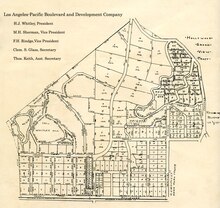
H.J. Whitley, a real estate developer, arranged to buy the 480-acre (1.9 km2) E.C. Hurd ranch. They agreed on a price and shook hands on the deal. Whitley shared his plans for the new town with General Harrison Gray Otis, publisher of the Los Angeles Times, and Ivar Weid, a prominent businessman in the area.[citation needed]
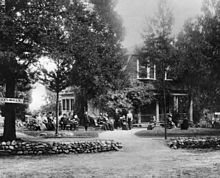
Daeida Wilcox, who donated land to help in the development of Hollywood, learned of the name Hollywood from an acquaintance who owned an estate by that name in Illinois.[1] Mrs. Wilcox is quoted as saying, "I chose the name Hollywood simply because it sounds nice and because I'm superstitious and holly brings good luck."[2] She recommended the same name to her husband, Harvey H. Wilcox, who had purchased 120 acres on February 1, 1887. It wasn't until August 1887 Wilcox decided to use that name and filed with the Los Angeles County Recorder's office on a deed and parcel map of the property.
By 1900, the region had a post office, newspaper, hotel, and two markets. Los Angeles, with a population of 102,479 lay 10 miles (16 km) east through the vineyards, barley fields, and citrus groves. A single-track streetcar line ran down the middle of Prospect Avenue from it, but service was infrequent and the trip took two hours. The old citrus fruit-packing house was converted into a livery stable, improving transportation for the inhabitants of Hollywood.

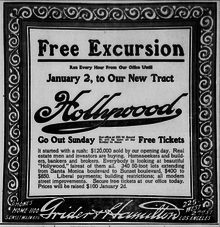
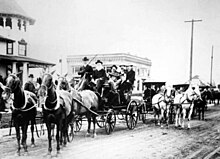
The Hollywood Hotel was opened in 1902 by Whitley, who was a president of the Los Pacific Boulevard and Development Company. Having finally acquired the Hurd ranch and subdivided it, Whitley built the hotel to attract land buyers. Flanking the west side of Highland Avenue, the structure fronted on Prospect Avenue (later Hollywood Boulevard), which, though still a dusty, unpaved road, was regularly graded and graveled. The hotel was to become internationally known and was the center of the civic and social life and home of the stars for many years.
Whitley's company developed and sold one of the early residential areas, the Ocean View Tract.[3] Whitley did much to promote the area. He paid thousands of dollars for electric lighting, including bringing electricity and building a bank, as well as a road into the Cahuenga Pass. The lighting ran for several blocks down Prospect Avenue. Whitley's land was centered on Highland Avenue.[4][5] His 1918 development, Whitley Heights, was named for him.
Incorporation and mergerHollywood was incorporated as a municipality on November 14, 1903, by a vote of 88 for and 77 against. On January 30, 1904, the voters in Hollywood decided, by a vote of 113 to 96, to banish the sale of liquor within the city, except for medicinal purposes. Neither hotels nor restaurants were allowed to serve wine or liquor before or after meals.[6]
In 1910, the city voted for a merger with Los Angeles in order to secure an adequate water supply and to gain access to the L.A. sewer system.
With annexation, the name of Prospect Avenue was changed to Hollywood Boulevard and all the street numbers in the new district changed. For example, 100 Prospect Avenue, at Vermont Avenue, became 6400 Hollywood Boulevard; and 100 Cahuenga Boulevard, at Hollywood Boulevard, changed to 1700 Cahuenga Boulevard.[7]
Motion picture industry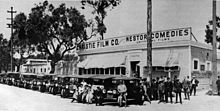
By 1908, at least 30 motion-picture companies began to set up production around Jacksonville, Florida, attracted by the warmer winter climate, rail access, and cheaper labor than New York, but left due to East Coast climate extremes, and politics. Kalem Studios was the first to arrive, in 1908, then in 1911, Kalem was the first to begin production near or in Los Angeles.[8]
By 1912, major motion-picture companies had set up production near or in Los Angeles.[9] In the early 1900s, most motion picture patents were held by Thomas Edison's Motion Picture Patents Company in New Jersey, and filmmakers were often sued to stop their productions. To escape this, filmmakers began moving to Los Angeles, where attempts to enforce Edison's patents were easier to evade.[10] Also, the weather was ideal and there was quick access to various settings. Los Angeles became the capital of the film industry in the United States.[11] The mountains, plains and low land prices made Hollywood a good place to establish film studios.[12]
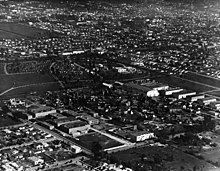
Director D. W. Griffith was the first to make a motion picture in Hollywood. His 17-minute short film In Old California (1910) was filmed for the Biograph Company.[13][14][15] Although Hollywood banned movie theaters—of which it had none—before annexation that year, Los Angeles had no such restriction.[16]
The first studio in Hollywood, the Nestor Film Company, was established by the New Jersey-based Centaur Film Company in a roadhouse at 6121 Sunset Boulevard (the corner of Gower), in October 1911.[17][18] Four major film companies – Paramount, Warner Bros., RKO, and Columbia – had studios in Hollywood, as did several minor companies and rental studios. In the 1920s, Hollywood was the fifth-largest industry in the nation.[11][clarification needed] By the 1930s, Hollywood studios became fully vertically integrated, as production, distribution and exhibition was controlled by these companies, enabling Hollywood to produce 600 films per year.[12]
Hollywood became known as Tinseltown[19] and the "dream factory"[12] because of the glittering image of the movie industry.
Further development
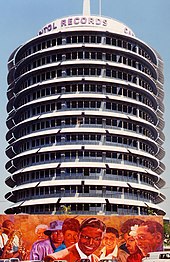
A large sign reading HOLLYWOODLAND was erected in the Hollywood Hills in 1923 to advertise real estate developers Woodruff's and Shoults' housing development. In 1949, the Hollywood Chamber of Commerce entered a contract with the City of Los Angeles to repair and rebuild the sign. The agreement stipulated that LAND be removed to spell HOLLYWOOD so the sign would now refer to the district, rather than the housing development.[20]
During the early 1950s, the Hollywood Freeway was constructed through the northeast corner of Hollywood.
The Capitol Records Building on Vine Street, just north of Hollywood Boulevard, was built in 1956, and the Hollywood Walk of Fame was created in 1958 as a tribute to artists and other significant contributors to the entertainment industry. The official opening was on February 8, 1960.[21][22][23]
The Hollywood Boulevard Commercial and Entertainment District was listed in the National Register of Historic Places in 1985.
In June 1999, the Hollywood extension of the Los Angeles County Metro Rail Red Line subway opened from Downtown Los Angeles to the San Fernando Valley, with stops along Hollywood Boulevard at Western Avenue (Hollywood/Western Metro station), Vine Street (Hollywood/Vine Metro station), and Highland Avenue (Hollywood/Highland Metro station).
The Dolby Theatre, which opened in 2001 as the Kodak Theatre at the Hollywood & Highland Center mall, is the home of the Oscars. The mall is located where the historic Hollywood Hotel once stood.
RevitalizationAfter the neighborhood underwent years of serious decline in the 1980s, many landmarks were threatened with demolition.[24] Columbia Square, at the northwest corner of Sunset Boulevard and Gower Street, is part of the ongoing rebirth of Hollywood. The Art Deco-style studio complex, completed in 1938, was once the Hollywood headquarters for CBS. It became home to a new generation of broadcasters when cable television networks MTV, Comedy Central, BET and Spike TV consolidated their offices there in 2014 as part of a $420 million office, residential and retail complex.[25] Since 2000, Hollywood has been increasingly gentrified due to revitalization by private enterprise and public planners.[26][27][28] Over 1,200 hotel rooms have been added in Hollywood area between 2001 and 2016. Four thousand new apartments and over thirty low to mid-rise development projects were approved in 2019.[29]
Secession movementIn 2002, some Hollywood voters began a campaign for the area to secede from Los Angeles and become a separate municipality. In June of that year, the Los Angeles County Board of Supervisors placed secession referendums for both Hollywood and the San Fernando Valley on the ballot. To pass, they required the approval of a majority of voters in the proposed new municipality as well as a majority of voters in all of Los Angeles. In the November election, both measures failed by wide margins in the citywide vote.[30]
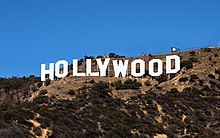















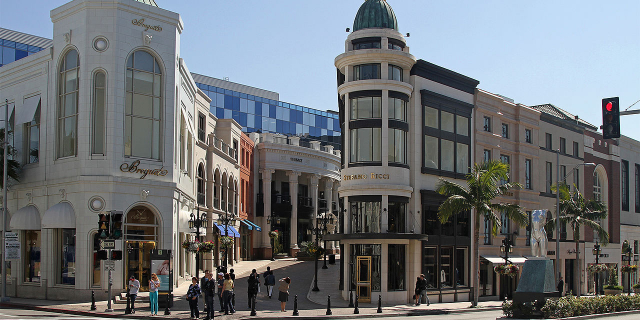



















Add new comment